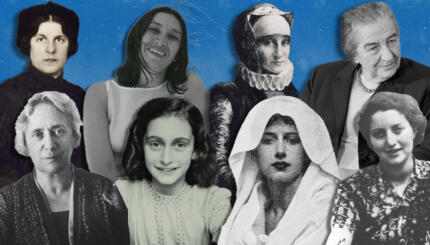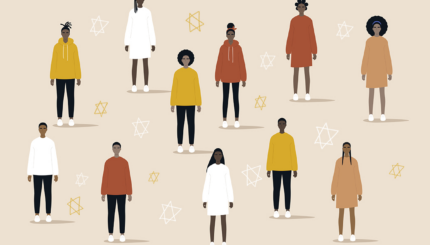Reprinted with permission from Sh’ma magazine.
In our ever-changing world the very bedrock of human society is shifting beneath our feet. At least it feels that way as we survey the contemporary Jewish family in America. We no longer take for granted the existence of a typical Jewish family/household, one of whose main tasks is to create and nurture future citizens of the Jewish community.
First there are the structural changes. The most common Jewish American household according to the National Jewish Population Survey of 1990 was one adult Jew living alone. Two adult Jews living together followed, and only then did we find the assumed normative household: two adult Jews, married to each other and with at least one child under the age of 18.
 This last configuration accounted for about 15 percent of Jewish households; nearly one-third of mixed married nuclear families were included in the tally. Single parent households through divorce or by choice, interracial families, as well as gay couples with children have become more common and more visible in the Jewish and general American communities.
This last configuration accounted for about 15 percent of Jewish households; nearly one-third of mixed married nuclear families were included in the tally. Single parent households through divorce or by choice, interracial families, as well as gay couples with children have become more common and more visible in the Jewish and general American communities.

Help us keep Jewish knowledge accessible to millions of people around the world.
Your donation to My Jewish Learning fuels endless journeys of Jewish discovery. With your help, My Jewish Learning can continue to provide nonstop opportunities for learning, connection and growth.
Internal Changes
Second, within the households that appear structurally intact we find profound internal changes. One or both spouses might be in their second marriage and one or both might be converts to Judaism. As a consequence, among the children one could find those who were “yours,” “mine,” and “ours”; those who were Jewish, half-Jewish, or Christian; those who had the same grandparents, aunts, uncles, and cousins; and those who had some but not all in common. What sociologists call “families of orientation,” that is, the nuclear family into which a person is born, have become increasingly heterogeneous and fragmented. As well, the revolution in gender roles has also significantly influenced the internal functioning of families popularly known as “married with children.”
Third, “families of procreation” have been delayed, with the age at first marriage becoming progressively older for Jewish women and men. Though by mid-century Jews were hailed in the general demographic literature as the most effective users of birth control in American society, it wasn’t until the late-1960s that analysts of contemporary Jewish life noted the aggregate results of this skill combined with other economic and social factors. By the mid-1960s, the Jewish birthrate was below 2.1, the zero population growth (ZPG) level. By the time of the 1970 NJPS, the Jewish birthrate for the previous decade was projected at well below ZPG, a trend maintained through 1990.
What most commentators on the “fertility” question failed to note was that the U.S. birthrate was converging with that of the Jewish community. But if Jews were a smaller proportion of the total U.S. population, it was not primarily due to low or well planned fertility, but rather to the loss of young Jews to what sociologist Marshall Sklare had felicitously termed “sociological death.” In the 1970s Sklare postulated that assimilation, intermarriage, apostasy, and conversion out of Judaism constituted a “sociological death” as powerful as the classic demographic variables of birth and mortality. And the findings two decades later–that more than 80 percent of the children of mixed marriage do not choose Judaism when they become adults–confirms his analysis.
Consequences for the Community
In the rhetoric of everyday Jewish communal life the consequences of delayed marriage and fertility for the life journeys of adult Jews have largely been ignored in favor of communal breast-beating over the absence of their unconceived children. Among the consequences of deferred and lowered fertility are that most Jewish adults are not living in “Dick and Jane” households. However, many communal institutions–including most synagogues–have not reprogrammed to accommodate the particular needs of a changing Jewish community. In the traditional Eastern European Jewish communities from which most North American Jews emigrated, only upon marrying did the person enter into full adulthood (and in some cases a person was not even counted as an adult until becoming a parent). The persistent echoes of this definition have led some of the best and brightest of our 21-35 year-olds out of Jewish communal life.
Finally, our sometimes too amorphous and sometimes too exacting definitions of family exclude grandparents, aunts, uncles, and cousins. This nuclear family bias derives from an American societal emphasis on upward mobility, which was understood to be accomplished, in part, through streamlining family obligations. While initial barriers of immigration and the ravages of the [Holocaust] limited the presence of extended family in the daily life of American Jews, internal migration in the search for the brass ring continued that trend.
Today the era of isolated nuclear families is at an end. We are blessed with many three- and four-generation Jewish families in the U.S. and some even live within a geographic proximity. Incorporating extended family into the everyday definition of mishpachah [Hebrew for “family”], whether or not they live in the same household or city, is essential to weaving a new and stronger fabric of Jewish family life.


